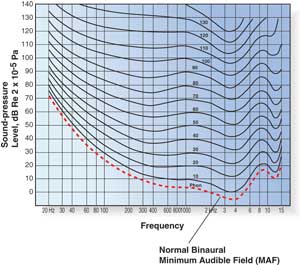At present, many people like their amp with attenuator, power scaling, or they have to buy smaller amp , so they can use amp in different place.Let us watch Fletcher Munson curve , we can found many interesting things which tell us how to know about guitar amp.

If you drive 100 watts worth of speakers with 60 mW, it will sound thin and fizzy. This is not the fault of the power attenuator; the speakers aren't designed to respond correctly with such low wattage. Try reducing your cab wattage capacity when attenuating down to the milliwatt (TV) level.
At same way if you drive 5 watts speaker and wish it have same sound as you drive 100watts speaker, It is impossible. Why is it? Please watch
From Fletcher Munson curve
We can know.
1. The high intensity is, the flat curve is. It means that peoples are sensitive to bass and high freq harmonics during high intensity sound. So the higher intensity sound will have more dynamic depth . Although smaller amp maybe have same harmonics, but people can not feel it. Please compare 60dB curve with 100dB curve. In 60 dB, only 700HZ-2000HZ, feeling is 60(phon), below 700HZ, it is below 50(phon). Harmonics and resonances drop off dramatically as volume is decreased.
2. If smaller amp want to have same dynamic depth as bigger amp, The bass and high freq of sound must have more compensation.
3. When we use attenuator or change power of amp( include VVR ,or power scaling), the feeling of sound will be changed, so we must compensate bass and hi freq . High freq sound is sensitive than bass sound.
4. Fletcher Munson curve, we can know each kind of amp need compensate bass and high freq, the freq curve of amp cann’t be flat, they must high in bass and hi freq. but How and where ,it is know-how.
5. Hi freq is more sensitive than bass freq . Hi freq sound arrive to same feeling need lower intensity than bass freq sound.

If you drive 100 watts worth of speakers with 60 mW, it will sound thin and fizzy. This is not the fault of the power attenuator; the speakers aren't designed to respond correctly with such low wattage. Try reducing your cab wattage capacity when attenuating down to the milliwatt (TV) level.
At same way if you drive 5 watts speaker and wish it have same sound as you drive 100watts speaker, It is impossible. Why is it? Please watch
From Fletcher Munson curve
We can know.
1. The high intensity is, the flat curve is. It means that peoples are sensitive to bass and high freq harmonics during high intensity sound. So the higher intensity sound will have more dynamic depth . Although smaller amp maybe have same harmonics, but people can not feel it. Please compare 60dB curve with 100dB curve. In 60 dB, only 700HZ-2000HZ, feeling is 60(phon), below 700HZ, it is below 50(phon). Harmonics and resonances drop off dramatically as volume is decreased.
2. If smaller amp want to have same dynamic depth as bigger amp, The bass and high freq of sound must have more compensation.
3. When we use attenuator or change power of amp( include VVR ,or power scaling), the feeling of sound will be changed, so we must compensate bass and hi freq . High freq sound is sensitive than bass sound.
4. Fletcher Munson curve, we can know each kind of amp need compensate bass and high freq, the freq curve of amp cann’t be flat, they must high in bass and hi freq. but How and where ,it is know-how.
5. Hi freq is more sensitive than bass freq . Hi freq sound arrive to same feeling need lower intensity than bass freq sound.

Comment